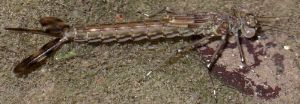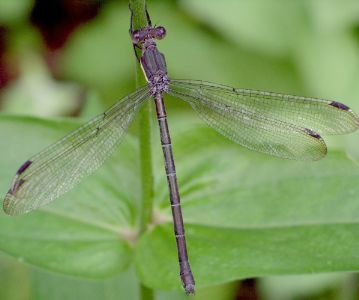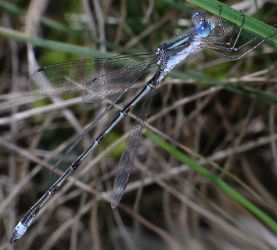
| Lestidae ~ Spreadwing Damsels |
|
This small family of damselflies breaks the rule that only dragonflies perch with their wings held out to the sides, hence the common name of spreadwings. They do sometimes hold their wings together, but only occasionally.
The adults are impressive, frequently preying on smaller species of damsels along with other kinds of insects. Both genders are metallic green mixed with brown on the top. They have a clear yellow stripe on each side of the thorax. Males are more slender, have a forked appendage on the whitish tip of their abdomen, and have blue eyes and faces. Females are thicker, with a very swollen and dark tip to their abdomen. They have dark faces. The two other spreadwings in our area are in the genus Lestes. They are not particularly common and look rather similar in appearance. Both are smaller than the Great Spreadwing but still on the large side for damselflies. The Southern Spreadwing (Lestes australis) has recently undergone a change in taxonomy. It used to be a subspecies of the Common Spreadwing (Lestes disjunctus), but has since been reclassified to species status. Males are blue, with extensive dark markings on top. They have a frosty whitish tip to their abdomen and white on the lower part of the thorax. Females are greenish metallic and brown, with a slight whitish tint to the abdomen tip and the same light lower sides to the thorax.
Easily confused with the previous species, the Plateau Spreadwing (Lestes alacer) has the same general colors. I have only photographed an immature male, which is brown, but mature males turn blue. The females are also brown, with less greenish tint than Southern Spreadwings. Both genders of the Plateau Spreadwing have less in the way of side markings on both the thorax and the abdomen than the Southern Spreadwing. The edges of the top dark stripe on the thorax are smoother on the Plateau Spreadwing than on the Southern Spreadwing. It is necessary to look quite closely at these two species to tell them apart. |
![]()






